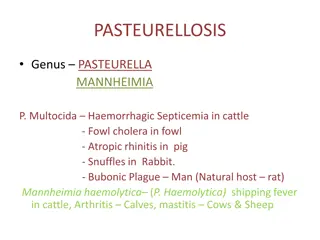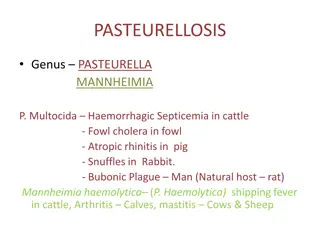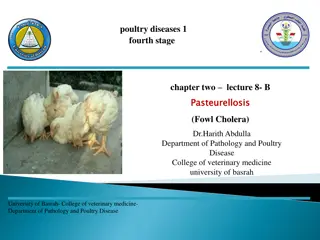Overview of Pasteurellosis in Livestock
Pasteurellosis, caused by Pasteurella and Mannheimia species, affects various animals from cattle to fowl. It presents as hemorrhagic septicemia in cattle, fowl cholera in fowl, atropic rhinitis in pigs, and more. The disease is characterized by small, non-hemolytic colonies and specific biochemical
0 views • 30 slides
Understanding Fowl Cholera in Birds: Causes, Symptoms, and Management
Fowl cholera, a septicaemic disease affecting birds, is caused by Pasteurella multocida. It can affect all species of birds, with older birds more susceptible. The disease can spread through carrier birds, excretions, carcasses, and even rats. The virulence factors, clinical signs, and forms of the
2 views • 9 slides
Understanding Pasteurellosis: A Bacterial Disease in Livestock
Pasteurellosis, caused by organisms like Pasteurella and Mannheimia, affects various animals including cattle, fowl, pigs, and rabbits. The disease presents as haemorrhagic septicaemia in cattle, with symptoms like high fever and respiratory distress. It is an important bacterial disease in livestoc
0 views • 30 slides
Understanding Pasteurellosis (Fowl Cholera) in Poultry: Causes, Symptoms, and Management
Pasteurellosis, also known as Fowl Cholera, is an acute septicemic disease affecting domestic fowl and wild birds caused by Pasteurella multocida. This disease is characterized by high morbidity and mortality rates, primarily impacting chickens, turkeys, and ducks. The disease spreads through health
0 views • 10 slides
Respiratory Diseases in Cattle: Causes, Infections, and Management
Respiratory diseases in cattle primarily stem from infectious agents such as infectious bovine rhinotracheitis and Pasteurella spp. These diseases compromise the defense mechanisms of the body, leading to infections like pneumonia and pleuropneumonia. Viruses, mycoplasmas, and bacteria like Histophi
0 views • 31 slides




